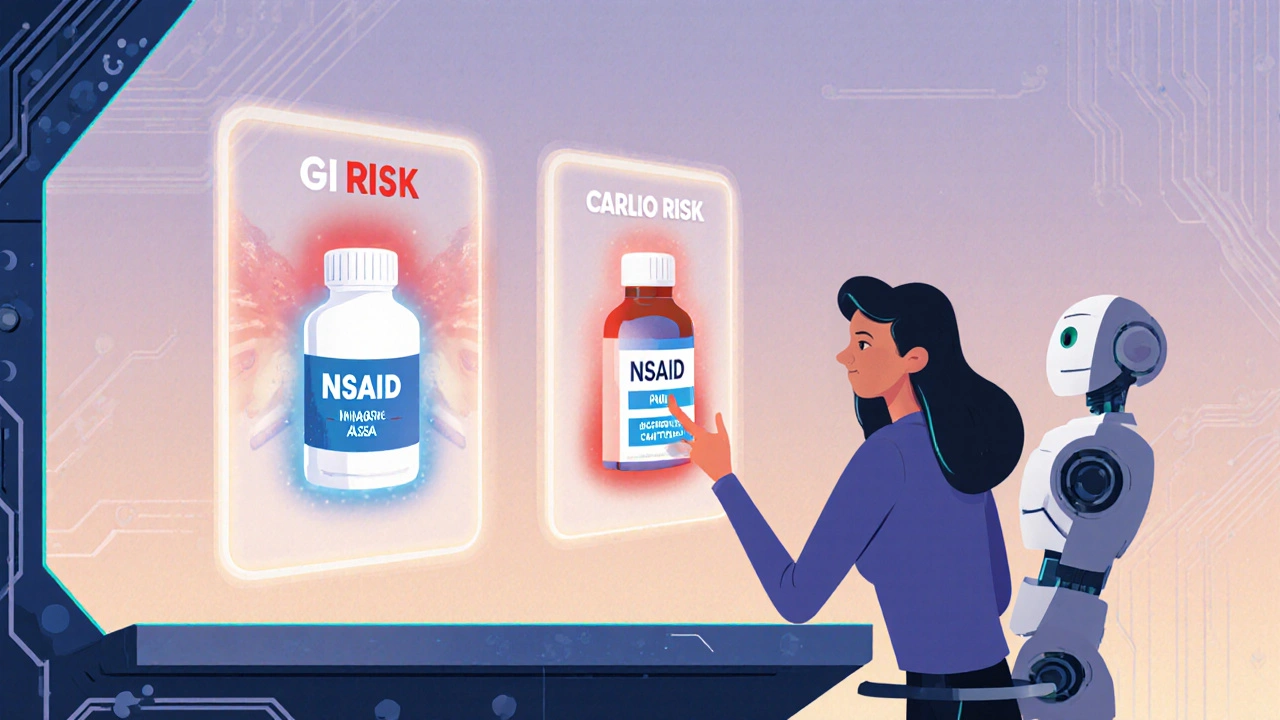NSAID Selection Tool
Find Your Best NSAID Match
Answer a few questions about your pain and health to get personalized recommendations.
Key Considerations
Important Notes
- NSAIDs can cause stomach bleeding and heart problems
- Never take more than prescribed
- Avoid alcohol while taking NSAIDs
- Talk to your doctor before starting any new medication
When inflammation spikes and over‑the‑counter pills aren’t cutting it, many people hear the name Feldene. But is it the best fit for you, or are there safer or more convenient options? This guide walks through Feldene (piroxicam) side‑by‑side with the most common NSAID alternatives, so you can decide with confidence.
Key Takeaways
- Feldene is a prescription‑only NSAID with a long half‑life, making it useful for chronic pain but raising GI‑risk concerns.
- Ibuprofen and naproxen are widely available OTC, have shorter half‑lives, and are generally easier on the stomach.
- Celecoxib is a COX‑2‑selective drug that lowers stomach irritation but may increase cardiovascular risk.
- Diclofenac offers strong anti‑inflammatory power but carries both GI and heart warnings.
- Choosing the right drug depends on dosage needs, existing health conditions, and how quickly you need relief.
What Is Feldene (Piroxicam)?
Feldene is a prescription non‑steroidal anti‑inflammatory drug (NSAID) whose active ingredient is piroxicam. It works by blocking the cyclooxygenase (COX) enzymes that produce prostaglandins, the chemicals that cause pain, swelling, and fever. Because of its long half‑life of about 50 hours, Feldene can maintain steady pain control with once‑daily dosing, which is handy for chronic conditions like rheumatoid arthritis.
How Feldene Works, Dosage, and Common Side Effects
The drug’s COX‑1 and COX‑2 inhibition reduces inflammation throughout the body, but it also interferes with the protective lining of the stomach. Typical adult doses start at 10 mg once daily, sometimes rising to 20 mg if tolerated. Common side effects include stomach upset, nausea, and, in rare cases, ulcers or bleeding. Because it stays in the system for days, any adverse reaction may linger longer than with shorter‑acting NSAIDs.
Popular NSAID Alternatives
Below are six widely used alternatives, each with its own strengths and drawbacks.
Ibuprofen is an OTC NSAID that blocks COX‑1 and COX‑2, providing quick relief for headaches, muscle aches, and mild arthritis. Its half‑life is 2‑4 hours, so it’s taken every 4‑6 hours as needed.
Naproxen offers a longer duration (half‑life around 12‑15 hours) than ibuprofen, making it suitable for sustained pain. Available both OTC and prescription, it’s often chosen for back pain or gout.
Celecoxib is a COX‑2‑selective NSAID that minimizes stomach irritation. It’s prescription‑only, and its half‑life is roughly 11 hours. Patients with ulcer history may prefer celecoxib, but it can raise the risk of heart attacks in susceptible individuals.
Diclofenac is a potent NSAID used for joint pain and postoperative inflammation. It’s available as tablets, gels, and patches. Its half‑life is about 1‑2 hours, but it’s often dosed twice daily. Like Feldene, it carries both GI and cardiovascular warnings.
Indomethacin is a prescription NSAID favored for gout and ankylosing spondylitis. It has a short half‑life (4‑5 hours) but a strong anti‑inflammatory effect. Its side‑effect profile includes a higher chance of stomach ulcers.
Meloxicam is another prescription NSAID with a half‑life of about 20 hours, allowing once‑daily dosing similar to Feldene. It leans slightly toward COX‑2 selectivity, offering a middle ground between efficacy and stomach safety.
Side‑by‑Side Comparison
| Drug | Class | Typical Dose | Onset | Half‑Life | GI Risk | Cardio Risk | OTC? |
|---|---|---|---|---|---|---|---|
| Feldene (Piroxicam) | Non‑selective NSAID | 10‑20 mg once daily | 1‑2 hours | ≈50 hours | High | Moderate | No |
| Ibuprofen | Non‑selective NSAID | 200‑400 mg every 4‑6 h | 30‑60 min | 2‑4 hours | Low‑Moderate | Low | Yes |
| Naproxen | Non‑selective NSAID | 250‑500 mg twice daily | 1‑2 hours | 12‑15 hours | Moderate | Low‑Moderate | Yes/Prescription |
| Celecoxib | COX‑2‑selective NSAID | 100‑200 mg once daily | 1‑2 hours | ≈11 hours | Low | High | No |
| Diclofenac | Non‑selective NSAID | 50‑75 mg two‑three times daily | 30‑60 min | 1‑2 hours | High | High | No |
| Indomethacin | Non‑selective NSAID | 25‑50 mg two‑three times daily | 30‑60 min | 4‑5 hours | High | Moderate | No |
| Meloxicam | COX‑2‑preferential NSAID | 7.5‑15 mg once daily | 1‑2 hours | ≈20 hours | Moderate | Moderate | No |

How to Choose the Right NSAID for You
Picking a pain reliever isn’t just about “stronger is better.” Consider these factors:
- Duration of pain. If you need steady relief for days on end, Feldene or meloxicam’s long half‑life shines. For short bursts, ibuprofen or naproxen may suffice.
- Stomach health. A history of ulcers or gastritis makes COX‑2‑selective options like celecoxib or lower‑dose ibuprofen more appealing.
- Heart condition. Patients with hypertension, coronary artery disease, or recent heart attacks should steer clear of diclofenac and high‑dose COX‑2 agents; discuss risks with a doctor.
- Convenience and cost. OTC drugs save a pharmacy visit and often cost less. Prescription NSAIDs may be covered by insurance for chronic disorders.
- Drug interactions. If you’re on blood thinners, steroids, or certain antidepressants, many NSAIDs-especially feldene-can increase bleeding risk.
Practical Tips for Safe Use
- Take the medication with food or a full glass of milk to cushion the stomach.
- Avoid alcohol while on any NSAID; it amplifies GI irritation.
- If you need both pain relief and a blood thinner, ask your clinician about a gastro‑protective agent like a proton‑pump inhibitor.
- Never exceed the recommended dose, even if pain feels unbearable.
- Monitor for warning signs: black stools, sudden weight loss, swelling of ankles, or chest pain. Seek medical help promptly.
Frequently Asked Questions
Is Feldene stronger than ibuprofen?
Strength isn’t the whole story. Feldene’s long half‑life provides steadier control, but ibuprofen works faster and is gentler on the stomach for most people.
Can I take Feldene with aspirin?
Combining two NSAIDs raises the risk of GI bleeding and kidney problems. Only do so if a doctor explicitly orders it.
What’s the best NSAID for someone with a history of ulcers?
COX‑2‑selective drugs like celecoxib generally cause fewer stomach issues, but they still need careful monitoring for heart health.
How long does it take for Feldene to start working?
Most people feel relief within 1‑2 hours, though the full anti‑inflammatory effect may take a day or two to build up.
Is it safe to use Feldene while pregnant?
NSAIDs, including feldene, are generally avoided in the third trimester because they can affect fetal circulation. Always check with a healthcare provider.
Bottom line: Feldene works great for long‑term, steady pain control, but its stomach and heart warnings mean it isn’t the first pick for everyone. Weigh the factors above, talk to your doctor, and you’ll land on the NSAID that fits your lifestyle and health profile.


Devendra Tripathi
October 21, 2025 AT 00:55Felden? More like a fancy placebo for people scared of real painkillers.
Ericka Suarez
October 22, 2025 AT 18:35Wow, look who’s trying to sound all “expert” – but let’s be real, you’re just spouting the same old pharma‑sponsored hype. The real issue is nobody tells you that every NSAID is basically a gamble with your gut and heart. If you think swapping ibuprofen for Feldene is a miracle, think again. Most of us can’t afford the pricey prescriptions anyway, so why push a drug that locks you into a daily habit? And don’t even get me started on the cardio warnings-it’s like playing roulette with your arteries. Honestly, the whole “once‑daily” convenience is a marketing trick for people who can’t handle the side‑effects.
Casey Cloud
October 24, 2025 AT 12:15Here’s a quick rundown of what you really need to consider when picking an NSAID. First look at half‑life – longer means steadier pain control but also longer exposure to side effects. Second, check your GI history – any ulcer or gastritis pushes you toward COX‑2‑selective options or adding a PP‑i. Third, evaluate cardiovascular risk – patients with hypertension or prior events should stay away from diclofenac and high‑dose celecoxib. Fourth, think about convenience and cost – OTC ibuprofen is cheap and easy, while prescription meloxicam may be covered by insurance for chronic arthritis. Finally, always discuss drug interactions, especially if you’re on blood thinners or steroids. Bottom line: match the drug profile to your personal risk factors rather than chasing the newest brand.
Rachel Valderrama
October 25, 2025 AT 16:01Oh great, another “quick rundown” – because we all have time to read a novel on NSAIDs while our knees are screaming.
Brandy Eichberger
October 27, 2025 AT 03:08I must say, the elegance of a well‑chosen NSAID mirrors the sophistication of a curated wardrobe – you wouldn’t wear sweatpants to a gala, just as you shouldn’t throw ibuprofen at a chronic rheumatoid flare. Selecting meloxicam for its balanced COX‑2 preference feels almost aristocratic in its restraint, whereas reckless high‑dose diclofenac is the sartorial equivalent of a gaudy neon suit.
Eli Soler Caralt
October 28, 2025 AT 20:48Ah, the contemplation of pain is a doorway to the soul, and the choice of a pill becomes a ritual of self‑understanding. When we pop a tablet, we are not merely silencing inflammation; we are negotiating with the body’s own language of warning. Each molecule of Feldene, ibuprofen, or celecoxib carries a story of centuries of chemistry, politics, and market forces. 🧪✨ Yet we often ignore that narrative, treating the drug as a simple switch. The half‑life of a medication is a reminder that time itself is part of the healing process – a long half‑life whispers patience, a short half‑life shouts urgency. In the garden of our physiology, COX‑1 and COX‑2 are twin vines that must be pruned with care. Over‑pruning leads to a barren stomach, under‑pruning leaves lingering inflammation. The philosopher in me asks: do we seek relief for the moment or strive for a balanced equilibrium? The answer may lie in the middle, where meloxicam’s preferential COX‑2 activity offers a compromise. But compromise is a double‑edged sword; it can mask deeper issues that demand lifestyle changes, not just chemical fixes. 🌿💊 Moreover, the heart‑risk warnings are a cautionary tale about the interconnectedness of bodily systems – a reminder that we cannot isolate one organ from the whole. Selecting an NSAID, then, becomes an act of humility, acknowledging the limits of our control. Ultimately, the most profound insight is that pain, whether chemical or existential, is an invitation to listen. And perhaps, in that listening, we discover that the strongest medicine is not a tablet at all, but the patience to endure and the wisdom to choose wisely. 🙏😊
Erika Thonn
October 30, 2025 AT 06:08Sometimes I wonder if the pain we feel is not just a chemical alarm but a whisper from the universe reminding us we are alive, even if the whisper comes wrapped in a pill.
Jake Hayes
October 31, 2025 AT 04:21Your poetic musing ignores the hard data-NSAIDs have measurable risks that cannot be brushed off as mystical whispers.
parbat parbatzapada
November 1, 2025 AT 08:08You know what they don’t tell you? The whole NSAID market is a controlled narrative designed by big pharma to keep us dependent on endless prescriptions, while the real freedom lies in natural anti‑inflammatories that they suppress.